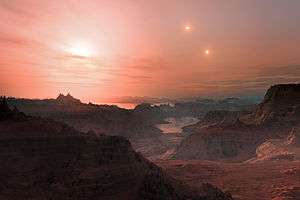HD 40307 g
HD 40307 g is an exoplanet orbiting in the habitable zone of HD 40307. It is located 42 light-years away in the direction of the southern constellation Pictor. The planet was discovered by the radial velocity method, using the European Southern Observatory's HARPS apparatus[5][10][11] by a team of astronomers led by Mikko Tuomi at the University of Hertfordshire and Guillem Anglada-Escude of the University of Goettingen, Germany.[12]
Composition theories
The codiscoverer Hugh Jones, of the University of Hertfordshire in England, surmised: "The longer orbit of the new planet means that its climate and atmosphere may be just right to support life." [10]
However, another astronomer, Rory Barnes of the University of Washington, had already studied the orbits of the planets b, c, and d. First, Barnes had presumed b to take on too much tidal heating for it to be terrestrial, instead predicting a "mini-Neptune". He thought that b, c, and d had all migrated inward,[13] which extrapolates to e and f as well, which are further out, but not by much. It is possible that HD 40307 g has also migrated into where it is now. The discoverers of HD 40307 g did not try to refute Barnes, on the nature of b and its extrapolation to the other planets. The composition of g is unsettled.[14] Lead author Mikko Tuomi, also of the University of Hertfordshire, stated "If I had to guess, I would say 50-50 ... But the truth at the moment is that we simply do not know whether the planet is a large Earth or a small, warm Neptune without a solid surface."[10]
See also
- Circumstellar habitable zone
- Extrasolar planet
- List of potentially habitable exoplanets
- Planetary habitability
References
- 1 2 3 4 5 "HD 40307". SIMBAD. Centre de Données astronomiques de Strasbourg. 2008. Retrieved 18 June 2008.
- ↑ HD 40307, entry, CDS database J/A+A/450/735; described in Effective temperature scale and bolometric corrections from 2MASS photometry, E. Masana, C. Jordi, and I. Ribas, Astronomy and Astrophysics 450, #2 (May 2006), pp. 735–746. Bibcode: 2006A&A...450..735M. doi:10.1051/0004-6361:20054021.
- 1 2 M. Mayor; S. Udry; C. Lovis; F. Pepe; D. Queloz; W. Benz; J.-L. Bertaux; F. Bouchy; C. Mordasini; D. Segransan (2009). "The HARPS search for southern extra-solar planets. XIII. A planetary system with 3 Super-Earths (4.2, 6.9, & 9.2 Earth masses)". Astronomy and Astrophysics. 493 (2): 639–644. arXiv:0806.4587
 . Bibcode:2009A&A...493..639M. doi:10.1051/0004-6361:200810451.
. Bibcode:2009A&A...493..639M. doi:10.1051/0004-6361:200810451. - ↑ HD 40307, database entry, Geneva-Copenhagen Survey of Solar neighbourhood, J. Holmberg et al., 2007, CDS database V/117A, accessed November 19, 2008; described in The Geneva-Copenhagen survey of the Solar neighbourhood. Ages, metallicities, and kinematic properties of ~14 000 F and G dwarfs, B. Nordström, M. Mayor, J. Andersen, J. Holmberg, F. Pont, B. R. Jørgensen, E. H. Olsen, S. Udry, and N. Mowlavi, Astronomy and Astrophysics 418 (May 2004), pp. 989–1019, Bibcode: 2004A&A...418..989N, doi:10.1051/0004-6361:20035959.
- 1 2 3 4 5 6 Tuomi, Mikko; Anglada-Escude, Guillem; Gerlach, Enrico; Jones, Hugh R. R.; Reiners, Ansgar; Rivera, Eugenio J.; Vogt, Steven S.; Butler, R. Paul (2012). "Habitable-zone super-Earth candidate in a six-planet system around the K2.5V star HD 40307". arXiv:1211.1617v1
 [astro-ph].
[astro-ph]. - 1 2 PHL's Exoplanets Catalog - Planetary Habitability Laboratory @ UPR Arecibo
- ↑ http://arxiv.org/pdf/1301.6674.pdf
- 1 2 3 Brasser, R.; Ida, S.; Kokubo, E. (2014). "A dynamical study on the habitability of terrestrial exoplanets - II the super-Earth HD 40307 g". Monthly Notices of the Royal Astronomical Society. 440 (4): 3685. arXiv:1403.5868
 . Bibcode:2014MNRAS.440.3685B. doi:10.1093/mnras/stu555.
. Bibcode:2014MNRAS.440.3685B. doi:10.1093/mnras/stu555. - 1 2 "HEC: Data of Potential Habitable Worlds". University of Puerto Rico at Arecibo (Planetary Habitability Laboratory). November 12, 2012.
- 1 2 3 Wall, Mike (November 7, 2012). "'Super-Earth' Alien Planet May Be Habitable for Life". Space.com. Retrieved November 8, 2012.
- ↑ Tate, Karl (November 7, 2012). "Super-Earth Planet: Potentially Habitable Alien World Explained (Infographic)". Space.com. Retrieved November 8, 2012.
- ↑ Murrin, Marc (November 8, 2012). "Astronomers discover a potentially habitable Super-Earth HD 40307g (Infographic)". tech-stew.com. Retrieved November 8, 2012.
- ↑ Barnes, R.; Jackson, B.; Raymond, S.; West, A.; Greenberg, R. (2009). "The HD 40307 Planetary System: Super-Earths or Mini-Neptunes?". The Astrophysical Journal. 695 (2): 1006. arXiv:0901.1698
 . Bibcode:2009ApJ...695.1006B. doi:10.1088/0004-637X/695/2/1006.
. Bibcode:2009ApJ...695.1006B. doi:10.1088/0004-637X/695/2/1006. - ↑ University of Toronto astronomer Ray Jayawardhana, author of Strange New Worlds: The Search for Alien Planets and Life beyond Our Solar System. Paraphrased in Dan Vergano (November 7, 2012). "Habitable zone 'Super Earth' candidate planet detected".
External links
- "Super-Earth Discovered in Star's Habitable Zone". Exoplanets.
Coordinates: ![]() 05h 54m 04.2409s, −60° 01′ 24.498″
05h 54m 04.2409s, −60° 01′ 24.498″

